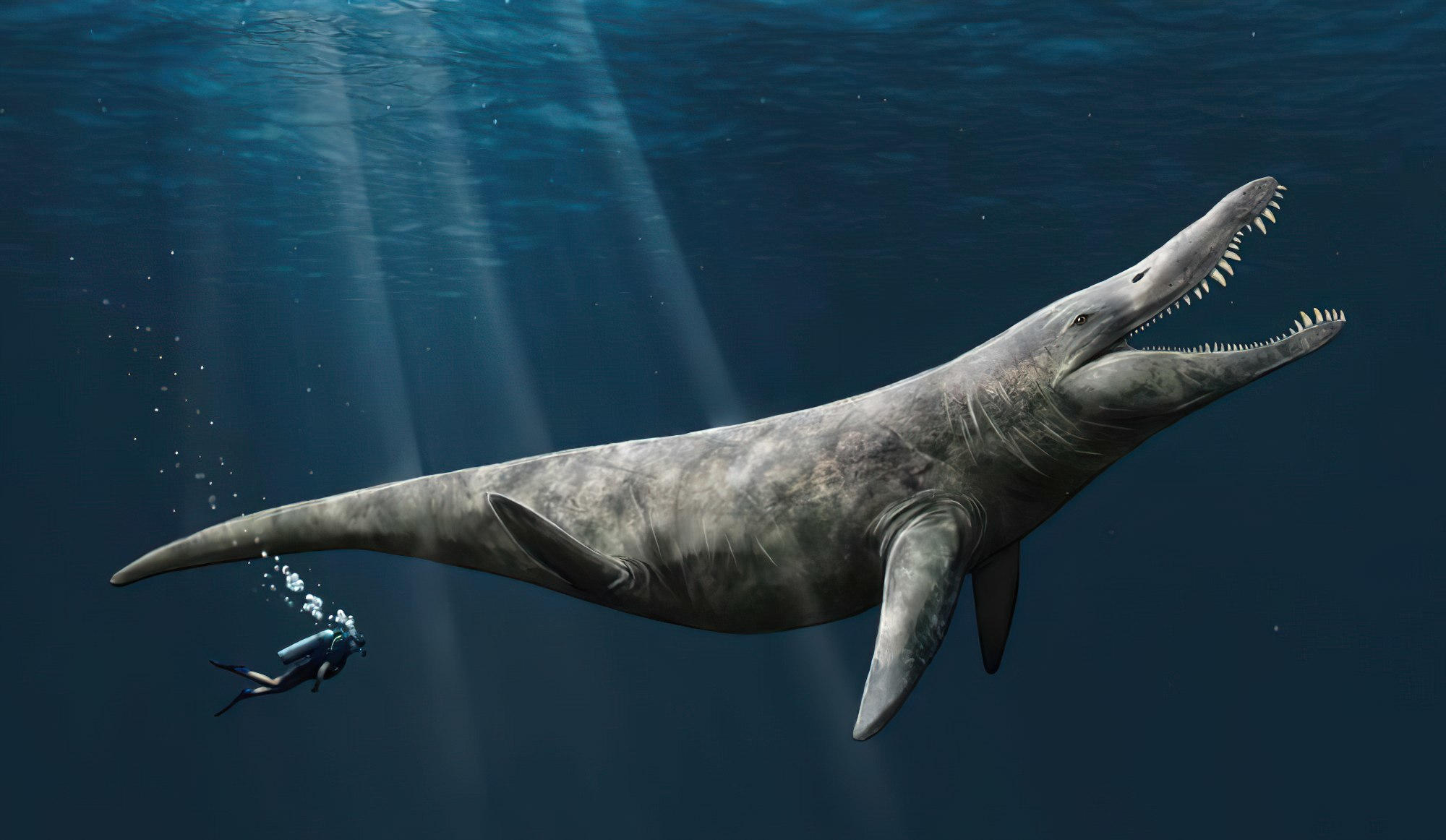

Egy művész benyomása egy pliosaurusról. Köszönetnyilvánítás: Megan Jacobs, University of Portsmouth
Több mint két évtizeddel ezelőtt 25 méter hosszúsággal fényképezték le liopleuron A BBC dokumentumfilm-sorozatában, a Walking with Dinosaurs-ban heves viták alakultak ki e plioszauruszok valódi méretéről. Az ábrázolásokat általában túlzottan eltúlzottnak tartották, a legelfogadottabb elmélet szerint a felnőtt Liopleuronok mérete valamivel több, mint hat méter.
Az ilyen találgatások azonban várhatóan folytatódni fognak, és most az Oxfordshire Múzeumban történt serény felfedezés arra ösztönözte a Portsmouthi Egyetem paleontológusait, hogy tegyenek közzé egy tanulmányt, amely hasonló felfedezést javasol.[{” attribute=””>species could reach a staggering length of 14.4 meters, twice the size of a killer whale.
Professor David Martill from the University of Portsmouth’s School of the Environment, Geography and Geosciences, said: “I was a consultant for the BBC’s pilot program‘ Cruel Sea’ and I hold my hands up – I got the size of Liopleurodon horrendously wrong. I based my calculations on some fragmentary material that suggested a Liopleurodon could grow to a length of 25 meters, but the evidence was scant and it caused a lot of controversy at the time.
“The size estimate on the BBC back in 1999 was overdone, but now we have some evidence that is much more reliable after a serendipitous discovery of four enormous vertebrates.”
Professor Martill’s co-author, Megan Jacobs, was photographing an ichthyosaur skeleton at Abingdon County Hall Museum, while Dave looked through drawers of fossils. He found a large vertebra and was thrilled to discover the curator had three more of them in storage.
The vertebrae are clearly identifiable as being closely related to a Pliosaurus species or similar animal. Pliosaurs were like plesiosaurs, but with a bigger elongated head, similar to a crocodile, and a shorter neck. They had four flippers, which acted as powerful paddles to propel them through water, and a relatively short tail.
After conducting topographic scans, Professor Martill and colleagues calculated this Late Jurassic marine reptile could have grown to between 9.8 and 14.4 meters long.
He said: “We know these pliosaurs were very fearsome animals swimming in the seas that covered Oxfordshire 145-152 million years ago. They had a massive skull with huge protruding teeth like daggers – as big, if not bigger than a T. rex, and certainly more powerful.
“They were at the top of the marine food chain and probably preyed on ichthyosaurs, long-necked plesiosaurs, and maybe even smaller marine crocodiles, simply by biting them in half and taking chunks off them. We know they were massacring smaller marine reptiles because you can see bite marks in ichthyosaur bones in examples on display in The Etches Collection in Dorset.”
The vertebrae were originally discovered during temporary excavations at Warren Farm in the River Thames Valley in Oxfordshire and come from the Kimmeridge Clay Formation. This deposit is Late Jurassic in age, around 152 million years old.
Professor Martill added: “It’s wonderful to prove there was indeed a truly gigantic pliosaur species in the Late Jurassic seas. Although not yet on a par with the claims made for Liopleurodon in the iconic BBC TV series Walking With Dinosaurs, it wouldn’t surprise me if one day we find some clear evidence that this monstrous species was even bigger.”
Reference: “A truly gigantic pliosaur (Reptilia, Sauropterygia) from the Kimmeridge Clay Formation (Upper Jurassic, Kimmeridgian) of England” by David M. Martill, Megan L. Jacobs and Roy E. Smith, 10 May 2023, Proceedings of the Geologists’ Association.
DOI: 10.1016/j.pgeola.2023.04.005

„Utazási specialista. Tipikus közösségi média tudós. Az állatok barátja mindenhol. Szabadúszó zombinindzsa. Twitter-barát.”





More Stories
A SpaceX Polaris Dawn űrszondájának legénysége a valaha volt legveszélyesebb űrsétára készül
Egy őskori tengeri tehenet evett meg egy krokodil és egy cápa a kövületek szerint
Egyforma dinoszaurusz-lábnyomokat fedeztek fel két kontinensen